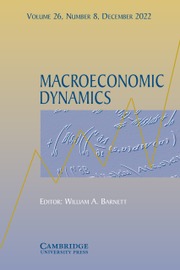No CrossRef data available.
Article contents
Optimal policies when price fairness matters
Published online by Cambridge University Press: 30 October 2025
Abstract
This paper examines optimal fiscal and regulatory policies within a New Keynesian (NK) framework that incorporates household fairness concerns regarding firm pricing behavior. Households derive utility not only from consumption and leisure but also from their perception of price fairness, which is influenced by biased beliefs about the price markup. These misperceptions reduce the effective price markup, as firms adjust pricing to avoid a demand backlash. The planner faces a trade-off between addressing monopolistic distortions, traditionally managed through the labor subsidy, and mitigating fairness concerns amplified by behavioral biases as spending increases. When biases are mild, the optimal fiscal policy remains the labor subsidy, though smaller than in the standard NK model. As fairness dynamics strengthen, the optimal policy shifts to a labor tax aimed at alleviating perceived unfair pricing, albeit with additional welfare losses. Capping the price markup can replicate the labor subsidy under moderate biases but loses effectiveness as fairness intensifies. These findings provide theoretical insights into how fairness-related behavioral distortions shape policymakers’ trade-offs and inform the design of optimal fiscal and regulatory policies.
Information
- Type
- Articles
- Information
- Copyright
- © The Author(s), 2025. Published by Cambridge University Press
Footnotes
The opinions and conclusions presented in this article are solely those of the author and do not necessarily reflect the official position of the European Central Bank, Lietuvos Bankas or the Eurosystem.

